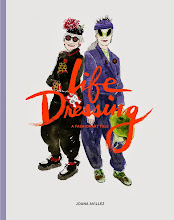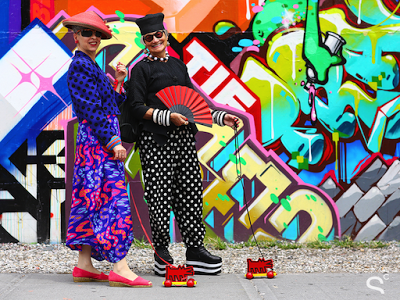In 2003, when Elizabeth Gibson unwittingly rescued Rufino Tamayo's Three People (Tres Personajes) at a curbside where it was waiting to be hauled away by the Sanitation Department, she gave new cachet to the pastime of dumpster diving. Almost two years ago, the Tamayo was auctioned at Sotheby's for just over $1 million, and Gibson received a nice finder's fee.
So on our way to The Japan Society for the opening of the Serizawa exhibition, we were not above stopping in front of an array of garbage probably 25 feet long to inspect a 34" x 50" framed cotton textile with psychedelic '70s characteristics carelessly placed on a discarded sofa that had clearly seen better days. Jean guessed, with admirable accuracy, that it was a Marimekko. Printing on the selvedge identified it as "Eve" by Katsuji Wakisaka, from 1972. In a moment, like car thieves, we were working - in all our finery - to strip the print from its frame so we could pocket it and get to the opening. But the framer had stapled the textile professionally, and as we had both neglected to bring our staple removers with us, we were forced to make a decision. We took the Marimekko home in its frame, making us late to the opening. (Well, what would YOU have done?!) While not exactly a million dollar lost Tamayo, it was nevertheless a small and enjoyable coup.
Our readers might remember that we were recently able to take photographs of ourselves inside the Guggenheim Museum. Having been raised in the '50s, when the zeitgeist turned away from the fast-talking women of the '30s and the capable, sacrificing women of the '40s, and morphed into the culture of that miserable Good Girl Who Values Her Reputation Above All Else, we are still trying to shake off the last vestiges of that deeply ingrained early training. Sometimes that means daring acts of slightly uncivil disobedience, like taking surreptitious photographs in museums. Our small group of about 15 people was followed everywhere by a guard (since the very informative and thoughtful tour was conducted after hours), so we took very few photographs. Just small gestures, really -- mostly to prove to ourselves that we are indeed Very Bad Girls. Below you can see Jean, apparently following the talk yet standing just slightly apart from the crowd, while Valerie, ostensibly resting her feet (why isn't there a bench in every room?), takes the forbidden picture.
After the tour, we looked for a small cafe in the neighborhood where we could have a wee post-lecture drinkie. At the first place we tried, which had two tiny tables free in its charming picture window, we were only invited to sit in what were clearly its "B List" seats. The waiter insisted that even after 9pm the petite tables at the window were reserved for patrons ordering dinners, not wee drinkies. This was puzzling because the tables were barely big enough to fit our elbows, much less dinner plates, but never mind. Off we went to the welcoming arms of Lumi's, just a few blocks south.
Lumi's is a cozy Italian bistro that one steps down into, giving a fresh perspective on passersby as one gazes out the windows, and the sprial staircase in the center of the front room also delights the eye. The staff invited us to sit wherever we liked, so we chose to sit in the back, warming ourselves after the chilly evening walk and the chillier reception at the previous restaurant (which we shall not name).
After ordering champagne cocktails, we realized that we were being photographed by a gentleman at the table next to us. He introduced himself as Fadil, and said he was a professional photographer. When he told us that he and the party at his table (including Lumi, the welcoming young owner, and Patrick, her gallant husband) had been talking about us and LOVED our style and our hats, we were hooked. (How easy it is to flatter us.) But when Fadil further stated that he was meeting the peerless Carmen dell'Orefice there for dinner, and that he would introduce us when she arrived, we were floored. Carmen is a role model for all women of a certain age, and all women who will one day become women of a certain age. She was the subject of Fadil's Rolex ad campaign geared to our demographic of choice.
Jean is wearing a black feathered '40s vintage hat (purchased at last spring's Metropolitan Pavilion Vintage Show), black Comme des Garcons wool jacket (with shoulders like a linebacker), black Michiko Koshino skirt, painted wood folk art rosary necklace from New Mexico, black Linda Leal long sleeve T-shirt, Dansko clogs, Gucci glasses and Lounge Fly bag.
Valerie wears a pink spiral velvet vintage Bonwit Teller hat, black silk Elizabeth Arden coat, black and gray shibori'd Gianni Versace jacket over a black Ivan Grundahl dress, James Minson glass necklace and black Aerosole flats.


No comments:
Post a Comment